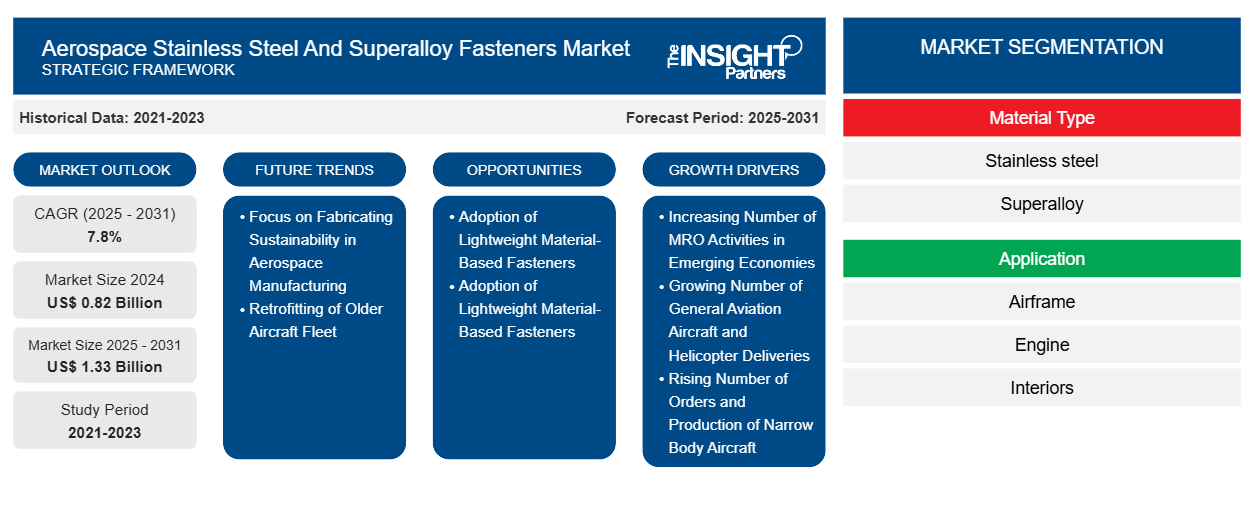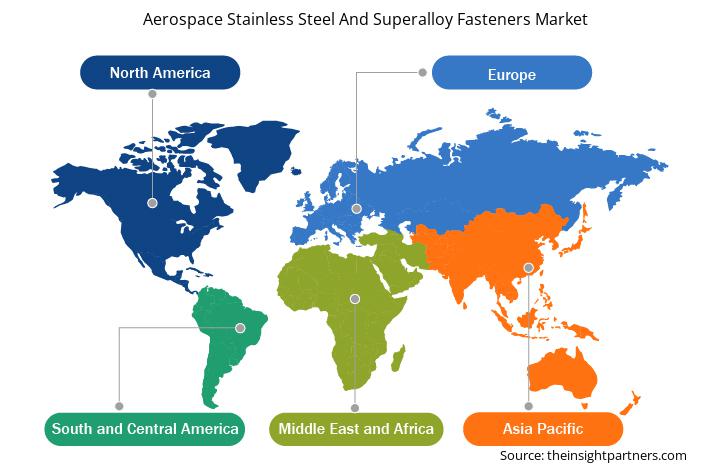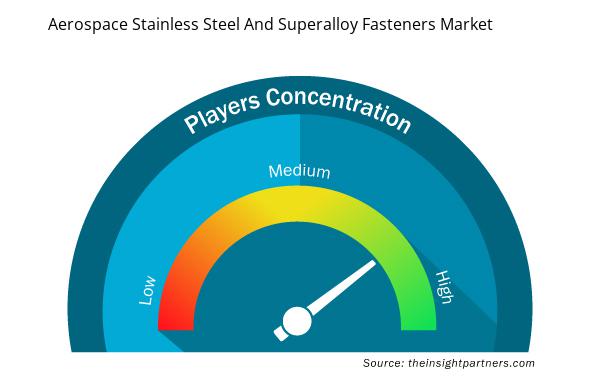航空航天不锈钢和高温合金紧固件市场规模预计将从 2024 年的 8.2 亿美元增至 2031 年的 13.3 亿美元。预计 2025-2031 年期间,该市场的复合年增长率将达到 7.8%。未来几年,航空航天制造业对制造可持续性的日益关注可能会成为市场的新趋势。
航空航天不锈钢和高温合金紧固件市场分析
推动航空航天不锈钢和超合金紧固件市场增长的关键因素包括新兴经济体的 MRO 活动不断增加、通用航空飞机和直升机交付量不断增加以及窄体飞机订单和产量不断增加。此外,在预测期内,模拟技术的整合预计将为市场中的关键参与者创造机会。
航空航天不锈钢和高温合金紧固件市场概况
航空航天不锈钢和超级合金紧固件市场分为北美、欧洲和亚太地区。这些地区有多家不锈钢和超级合金紧固件制造商和供应商,推动了市场的发展。TriMas、Precision Castparts Corp.、Howmet Aerospace Inc.、LISI Aerospace SAS、Saturn Fasteners, Inc.、National Aerospace Fasteners Corp. 和 Raychin Limited 是北美、欧洲和亚太地区的主要参与者。
2024 年 6 月,空客的 A330-900 飞行测试飞机 MSN1795/F-WTTN 飞往墨西哥托卢卡,然后飞往玻利维亚拉巴斯。这次测试是空客高空测试活动的一部分。空客正致力于提高 A350 和 A330neo 的产量,并致力于推出基于 A330neo 的货机。空客在 2023 年供应了 735 架商用飞机,比 2022 年增长约 11%。空客的商用飞机订单总数为 2,319 架,包括 1,835 架 A320 系列和 300 架 A350 系列飞机。2023 年,波音共交付了 528 架飞机,其中包括 396 架波音 737 喷气式飞机和 73 架梦想飞机。此外,2024 年 5 月,靛蓝航空与巴西航空工业公司、ATR 和空中客车公司合作订购了约 100 架小型飞机,旨在扩大其区域网络。因此,商用飞机领域的持续发展预计将在未来几年推动航空航天不锈钢和高温合金紧固件市场的增长。此外,由于新飞机机队生产的增加和 MRO 服务的增加,航空航天领域对不锈钢和高温合金紧固件的需求不断增长,正在推动北美、欧洲和亚太地区市场的增长。
航空客运量不断增长,这促使航空公司增加航班起降并开始使用新飞机。飞机 MRO 活动对于保持部件的可及性、一致性和质量至关重要。航空公司依靠 MRO 服务来确保飞机的安全并提高燃油效率,这影响了航空航天不锈钢和高温合金紧固件市场的增长。
亚太地区对飞机零部件维护和维修的需求正在激增。航空业的增长可能更集中在亚太地区,尤其是中国和印度。此外,新加坡和马来西亚是飞机 MRO 服务业增长的主要贡献者之一,这对航空不锈钢和高温合金紧固件市场产生了积极影响。预计亚太地区的航空业将强劲增长,这可能会在未来几年推动对航空紧固件的需求。
欧洲和北美地区对扩大飞机机队的投资增加也促进了这些地区航空航天不锈钢和高温合金紧固件市场的增长。此外,预计在预测期内,政府将增加对军用和国防飞机的融资或投资,以提高安全性并加强这些地区的国防部门,从而推动航空航天不锈钢和高温合金紧固件市场的增长。此外,印度、印度尼西亚、泰国和新加坡等亚太地区国家的旅游业增长预计将刺激对飞机机队的需求,从而推动航空航天不锈钢和高温合金紧固件市场的增长。
定制此报告以满足您的需求
您可以免费定制任何报告,包括本报告的部分内容、国家级分析、Excel 数据包,以及为初创企业和大学提供优惠和折扣
航空航天不锈钢和高温合金紧固件市场:

- 获取此报告的关键市场趋势。这个免费样品将包括数据分析,从市场趋势到估计和预测。
航空航天不锈钢和高温合金紧固件市场驱动因素和机遇
窄体飞机订单量和产量不断增加
多年来,航空航天业发展迅速,飞机生产和交付数量可观。这表明全球各商用飞机制造商的订单量巨大。随着航空旅行乘客和飞机数量的增加,预计未来几年商用航空业将激增。全球窄体客机和商用飞机订单的增加推动了对飞机支架的需求。随着航空旅行乘客数量的增加,航空公司正强调通过开通飞往较小城市机场的航线来扩展到更偏远的地区。随着飞机和机场数量的增加,对紧固件的需求也在增加。2023 年,波音公司和大湾区航空公司 (GBA) 获得了 15 架 737-9 飞机的订单。该协议还包括承诺提供五架 787 梦想飞机,以支持 GBA 推出国际长途服务的长期战略。
空客估计,2023 年至 2042 年期间将交付约 40,850 架新客机和货机,其中约 32,630 架为典型单通道飞机,8,220 架为典型宽体飞机。此外,预计货运飞机需求将达到约 2,510 架,同期新建货运飞机约 920 架。因此,窄体飞机订单数量和产量的增加推动了航空航天不锈钢和高温合金紧固件市场的增长。
全球飞机机队规模激增
根据 Insight Partners 的分析和各种航空航天业资源,2024 年全球现有商用飞机总数超过约 28,395 架,其中包括超过 17,260 架窄体飞机;约 5,755 架宽体飞机;约 3,040 架支线喷气式飞机;和约 2,334 架涡轮螺旋桨飞机。此外,到 2034 年,预计全球商用飞机总数将超过约 36,400 架,其中包括超过 22,974 架窄体飞机;约 7,400 架宽体飞机;约 3,465 架支线喷气式飞机;和约 2,565 架涡轮螺旋桨飞机。预计 2023 年至 2042 年,中国和印度的航空旅行量将增长 3.5% 以上。此外,根据 ch-aviation 关于全球飞机机队订单的数据,截至 2023 年 6 月,美国的飞机订单数量(不包括军用飞机和运营商/发动机不明的飞机)居世界首位,共订购 3,147 架飞机,其次是爱尔兰、中国和印度,飞机订单量分别为 1,247 架、1,239 架和 888 架。根据同一数据,飞机订单量最大的五大消费者分别是联合航空、靛蓝航空、狮航、航空租赁公司和亚洲航空,其中两家总部位于亚太地区。此外,根据各航空航天行业消息来源的分析,2024 年亚太地区商用飞机机队总规模为 8,653 架,到 2034 年底可能达到约 11,582 架。发动机和机身维护和维修似乎是 2024 年最突出的。因此,预计全球飞机机队规模的不断增长将在未来几年为飞机零部件供应商(包括不锈钢和高温合金紧固件制造商)创造新的机遇。
航空航天不锈钢和高温合金紧固件市场报告细分分析
有助于得出航空航天不锈钢和高温合金紧固件市场分析的关键部分是材料类型、应用、飞机类型和产品类型。
- 根据材料类型,航空航天不锈钢和超级合金紧固件市场分为不锈钢和超级合金。 2024 年,不锈钢部分占据了更大的市场份额。 此外,超级合金部分进一步细分为 A286、Inconel 718、Waspaloy 等。
- 根据应用,市场分为机身、发动机、内饰和其他。机身部分在 2024 年占据了最大的市场份额。
- 根据飞机类型,市场分为固定翼和旋翼。2024 年,固定翼飞机将占据更大的市场份额。
- 根据产品类型,市场分为螺钉、铆钉、螺母/螺栓和其他。2024 年,螺母/螺栓占据了最大的市场份额。
航空航天不锈钢和高温合金紧固件市场份额按地区分析
航空航天不锈钢和高温合金紧固件市场报告的地理范围主要分为三个主要区域:北美、亚太地区和欧洲。亚太地区在 2024 年占据了航空航天不锈钢和高温合金紧固件市场的主导地位;在预测期内,它很可能继续保持主导地位。亚太地区是一个庞大的航空消费群,人口超过 40 亿,经济充满活力,共占全球 GDP 的约 35%。根据 The Insight Partners 的分析,2024 年,亚太地区拥有超过 4,525 架投入运营的商用飞机,预计到 2034 年底将达到约 5,150 架商用飞机。亚太地区拥有超过约 2,263 架投入运营的窄体商用飞机,预计到 2034 年底将达到约 2,465 架。此外,亚太地区拥有超过约 1,360 架投入运营的宽体商用飞机,预计到 2034 年底将达到约 1,655 架。该地区的航空业对其社会和经济发展做出了重要贡献。亚太地区的增长主要归因于广泛的收入水平和快速增长的中产阶级。这导致印度和中国等亚太地区快速发展的经济体的订单增长强劲。预计亚太地区未来将为紧固件供应商提供充足的机会。亚太地区有多个正在发展的经济体,它们正引领航空航天、军事和国防以及技术等多个行业的增长。近年来,由于来自印度、中国、日本和台湾等国家的国际旅客数量不断增加,亚太地区大量进口现代商用飞机。该地区的机场数量正在增加,这反过来又推动了航空公司对飞机机队的需求。
航空航天不锈钢和高温合金紧固件市场区域洞察
Insight Partners 的分析师已详尽解释了预测期内影响航空航天不锈钢和超合金紧固件市场的区域趋势和因素。本节还讨论了北美、欧洲、亚太地区、中东和非洲以及南美和中美洲的航空航天不锈钢和超合金紧固件市场细分和地理位置。

- 获取航空航天不锈钢和高温合金紧固件市场的区域特定数据
航空航天不锈钢和高温合金紧固件市场报告范围
| 报告属性 | 细节 |
|---|---|
| 2024 年的市场规模 | 8.2亿美元 |
| 2031 年市场规模 | 13.3亿美元 |
| 全球复合年增长率(2025 - 2031) | 7.8% |
| 史料 | 2021-2023 |
| 预测期 | 2025-2031 |
| 涵盖的领域 | 按材料类型
|
| 覆盖地区和国家 | 北美
|
| 市场领导者和主要公司简介 |
|
航空航天不锈钢和高温合金紧固件市场参与者密度:了解其对业务动态的影响
航空航天不锈钢和超合金紧固件市场正在快速增长,这得益于最终用户需求的不断增长,这些需求源于消费者偏好的不断变化、技术进步以及对产品优势的认识不断提高等因素。随着需求的增加,企业正在扩大其产品范围,进行创新以满足消费者的需求,并利用新兴趋势,从而进一步推动市场增长。
市场参与者密度是指在特定市场或行业内运营的企业或公司的分布情况。它表明在给定市场空间中,相对于其规模或总市场价值,有多少竞争对手(市场参与者)存在。
在航空航天不锈钢和高温合金紧固件市场运营的主要公司有:
- 精密铸件公司
- 利西航空有限公司
- TriMas 航空
- 国家航空紧固件公司
- Howmet 航空航天公司
- STANLEY 工程紧固件
免责声明:上面列出的公司没有按照任何特定顺序排列。

- 了解航空航天不锈钢和高温合金紧固件市场的主要参与者概况
航空航天不锈钢和高温合金紧固件市场新闻和最新发展
通过收集一级和二级研究后的定性和定量数据来评估航空航天不锈钢和高温合金紧固件市场,其中包括重要的公司出版物、协会数据和数据库。下面列出了航空航天不锈钢和高温合金紧固件市场的一些发展情况:
TriMas 签署协议,收购 Weldmac Manufacturing Company(“Weldmac”)的经营净资产,Weldmac 是一家高性能、复杂金属制造部件和组件的设计商和制造商,产品面向航空航天、国防和航天发射终端市场。(来源:TriMas,新闻稿,2023 年)
- LISI AEROSPACE 与波音公司签署协议,延长其目前的工作说明。根据合同,LISI AEROSPACE 将继续提供近 6,000 个不同的零件编号,以支持所有波音商用项目(737、747、767、777 和 787)。(来源:LISI AEROSPACE,新闻稿,2022 年)
TriMas 是一家总部位于美国的跨国航空设备制造商和供应商,它直接收购了 TFI Aerospace Corporation。TFI 总部位于多伦多,是航空航天、运输和工业应用领域领先的特种紧固件制造商和供应商。(来源:TriMas,新闻稿,2021 年)
航空航天不锈钢和高温合金紧固件市场报告范围和交付成果
“航空航天不锈钢和高温合金紧固件市场规模和预测(2021-2031 年)”报告对市场进行了详细分析,涵盖以下领域:
- 航空航天不锈钢和高温合金紧固件市场规模及全球、区域和国家层面所有关键细分市场的预测
- 航空航天不锈钢和高温合金紧固件市场趋势,以及驱动因素、限制因素和关键机遇等市场动态
- 详细的波特五力分析和 SWOT 分析
- 航空航天不锈钢和高温合金紧固件市场分析,涵盖主要市场趋势、全球和区域框架、主要参与者、法规和最新市场发展
- 行业格局和竞争分析,涵盖市场集中度、热图分析、知名参与者以及航空不锈钢和高温合金紧固件市场的最新发展
- 详细的公司简介
- 历史分析(2 年)、基准年、预测(7 年)及复合年增长率
- PEST 和 SWOT 分析
- 市场规模价值/数量 - 全球、区域、国家
- 行业和竞争格局
- Excel 数据集


- Arterial Blood Gas Kits Market
- Unit Heater Market
- Authentication and Brand Protection Market
- Social Employee Recognition System Market
- Extracellular Matrix Market
- Molecular Diagnostics Market
- Genetic Testing Services Market
- Biopharmaceutical Contract Manufacturing Market
- Diaper Packaging Machine Market
- Green Hydrogen Market

Report Coverage
Revenue forecast, Company Analysis, Industry landscape, Growth factors, and Trends

Segment Covered
This text is related
to segments covered.

Regional Scope
North America, Europe, Asia Pacific, Middle East & Africa, South & Central America

Country Scope
This text is related
to country scope.
常见问题
Asia Pacific is anticipated to grow with the highest CAGR over the forecast period 2024-2031.
The stainless steel segment held the largest market share in 2023.
The key players, holding majority shares, in aerospace stainless steel and superalloy fasteners market includes Precision Castparts Corp., LISI Aerospace SAS, TriMas Aerospace, Howmet Aerospace Inc, and B&B Specialties, Inc.
Focus on fabricating sustainability in aerospace manufacturing is the future trends of the aerospace stainless steel and superalloy fasteners market.
Increasing number of MRO activities in emerging economies and growing number of general aviation aircraft and helicopter deliveries are the driving factors impacting the aerospace stainless steel and superalloy fasteners market.
The aerospace stainless steel and superalloy fasteners market was valued at US$ 0 million in 2023 and is projected to reach US$ 1,334.44 million by 2031; it is expected to grow at a CAGR of 7.4% during 2023–2031.
Trends and growth analysis reports related to Aerospace and Defense : READ MORE..
The List of Companies - Aerospace Stainless Steel and Superalloy Fasteners Market
- Precision Castparts Corp.
- LISI Aerospace SAS
- TriMas Aerospace
- National Aerospace Fasteners Corp.
- Howmet Aerospace Inc
- STANLEY Engineered Fastening
- Saturn Fasteners, Inc.
- B&B Specialties, Inc.
- RAYCHIN LIMITED
- MS Aerospace
The Insight Partners performs research in 4 major stages: Data Collection & Secondary Research, Primary Research, Data Analysis and Data Triangulation & Final Review.
- Data Collection and Secondary Research:
As a market research and consulting firm operating from a decade, we have published and advised several client across the globe. First step for any study will start with an assessment of currently available data and insights from existing reports. Further, historical and current market information is collected from Investor Presentations, Annual Reports, SEC Filings, etc., and other information related to company’s performance and market positioning are gathered from Paid Databases (Factiva, Hoovers, and Reuters) and various other publications available in public domain.
Several associations trade associates, technical forums, institutes, societies and organization are accessed to gain technical as well as market related insights through their publications such as research papers, blogs and press releases related to the studies are referred to get cues about the market. Further, white papers, journals, magazines, and other news articles published in last 3 years are scrutinized and analyzed to understand the current market trends.
- Primary Research:
The primarily interview analysis comprise of data obtained from industry participants interview and answers to survey questions gathered by in-house primary team.
For primary research, interviews are conducted with industry experts/CEOs/Marketing Managers/VPs/Subject Matter Experts from both demand and supply side to get a 360-degree view of the market. The primary team conducts several interviews based on the complexity of the markets to understand the various market trends and dynamics which makes research more credible and precise.
A typical research interview fulfils the following functions:
- Provides first-hand information on the market size, market trends, growth trends, competitive landscape, and outlook
- Validates and strengthens in-house secondary research findings
- Develops the analysis team’s expertise and market understanding
Primary research involves email interactions and telephone interviews for each market, category, segment, and sub-segment across geographies. The participants who typically take part in such a process include, but are not limited to:
- Industry participants: VPs, business development managers, market intelligence managers and national sales managers
- Outside experts: Valuation experts, research analysts and key opinion leaders specializing in the electronics and semiconductor industry.
Below is the breakup of our primary respondents by company, designation, and region:

Once we receive the confirmation from primary research sources or primary respondents, we finalize the base year market estimation and forecast the data as per the macroeconomic and microeconomic factors assessed during data collection.
- Data Analysis:
Once data is validated through both secondary as well as primary respondents, we finalize the market estimations by hypothesis formulation and factor analysis at regional and country level.
- Macro-Economic Factor Analysis:
We analyse macroeconomic indicators such the gross domestic product (GDP), increase in the demand for goods and services across industries, technological advancement, regional economic growth, governmental policies, the influence of COVID-19, PEST analysis, and other aspects. This analysis aids in setting benchmarks for various nations/regions and approximating market splits. Additionally, the general trend of the aforementioned components aid in determining the market's development possibilities.
- Country Level Data:
Various factors that are especially aligned to the country are taken into account to determine the market size for a certain area and country, including the presence of vendors, such as headquarters and offices, the country's GDP, demand patterns, and industry growth. To comprehend the market dynamics for the nation, a number of growth variables, inhibitors, application areas, and current market trends are researched. The aforementioned elements aid in determining the country's overall market's growth potential.
- Company Profile:
The “Table of Contents” is formulated by listing and analyzing more than 25 - 30 companies operating in the market ecosystem across geographies. However, we profile only 10 companies as a standard practice in our syndicate reports. These 10 companies comprise leading, emerging, and regional players. Nonetheless, our analysis is not restricted to the 10 listed companies, we also analyze other companies present in the market to develop a holistic view and understand the prevailing trends. The “Company Profiles” section in the report covers key facts, business description, products & services, financial information, SWOT analysis, and key developments. The financial information presented is extracted from the annual reports and official documents of the publicly listed companies. Upon collecting the information for the sections of respective companies, we verify them via various primary sources and then compile the data in respective company profiles. The company level information helps us in deriving the base number as well as in forecasting the market size.
- Developing Base Number:
Aggregation of sales statistics (2020-2022) and macro-economic factor, and other secondary and primary research insights are utilized to arrive at base number and related market shares for 2022. The data gaps are identified in this step and relevant market data is analyzed, collected from paid primary interviews or databases. On finalizing the base year market size, forecasts are developed on the basis of macro-economic, industry and market growth factors and company level analysis.
- Data Triangulation and Final Review:
The market findings and base year market size calculations are validated from supply as well as demand side. Demand side validations are based on macro-economic factor analysis and benchmarks for respective regions and countries. In case of supply side validations, revenues of major companies are estimated (in case not available) based on industry benchmark, approximate number of employees, product portfolio, and primary interviews revenues are gathered. Further revenue from target product/service segment is assessed to avoid overshooting of market statistics. In case of heavy deviations between supply and demand side values, all thes steps are repeated to achieve synchronization.
We follow an iterative model, wherein we share our research findings with Subject Matter Experts (SME’s) and Key Opinion Leaders (KOLs) until consensus view of the market is not formulated – this model negates any drastic deviation in the opinions of experts. Only validated and universally acceptable research findings are quoted in our reports.
We have important check points that we use to validate our research findings – which we call – data triangulation, where we validate the information, we generate from secondary sources with primary interviews and then we re-validate with our internal data bases and Subject matter experts. This comprehensive model enables us to deliver high quality, reliable data in shortest possible time.

 获取此报告的免费样本
获取此报告的免费样本